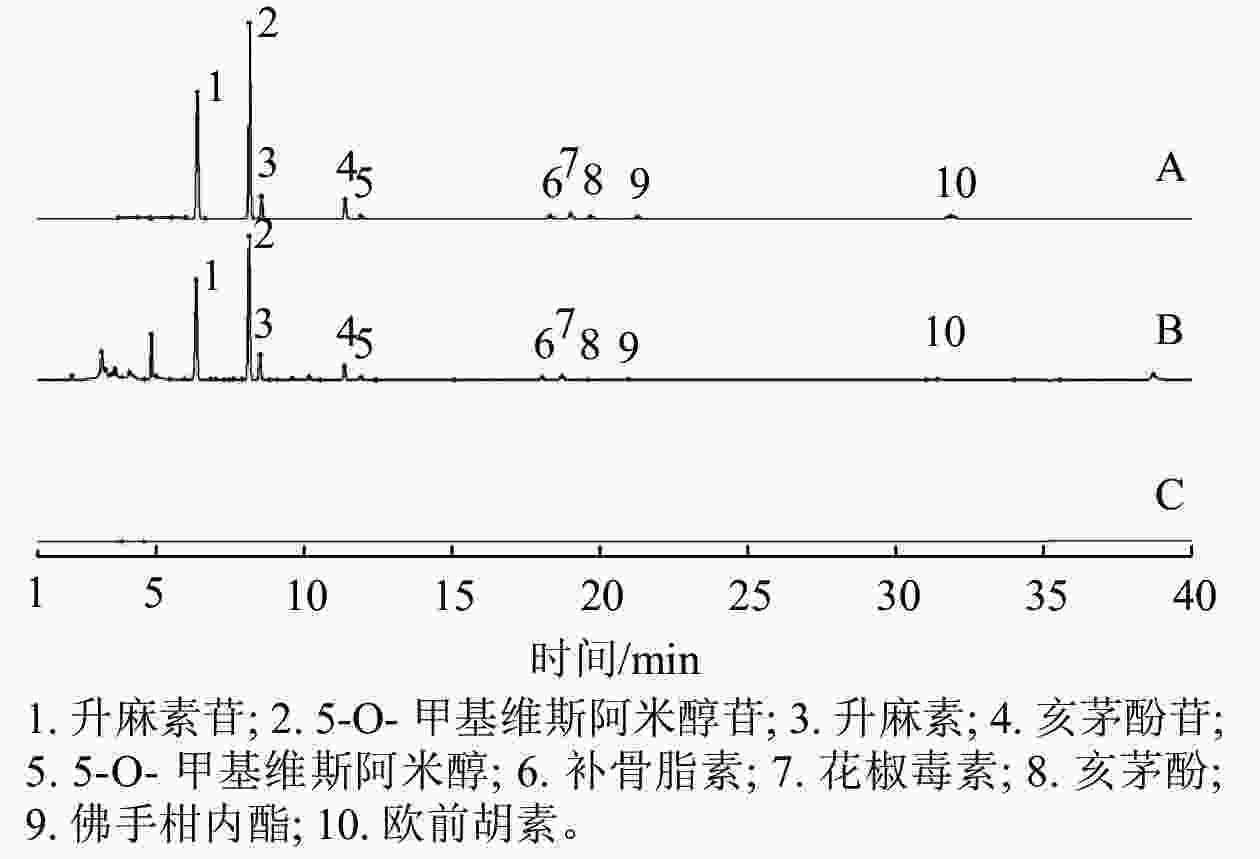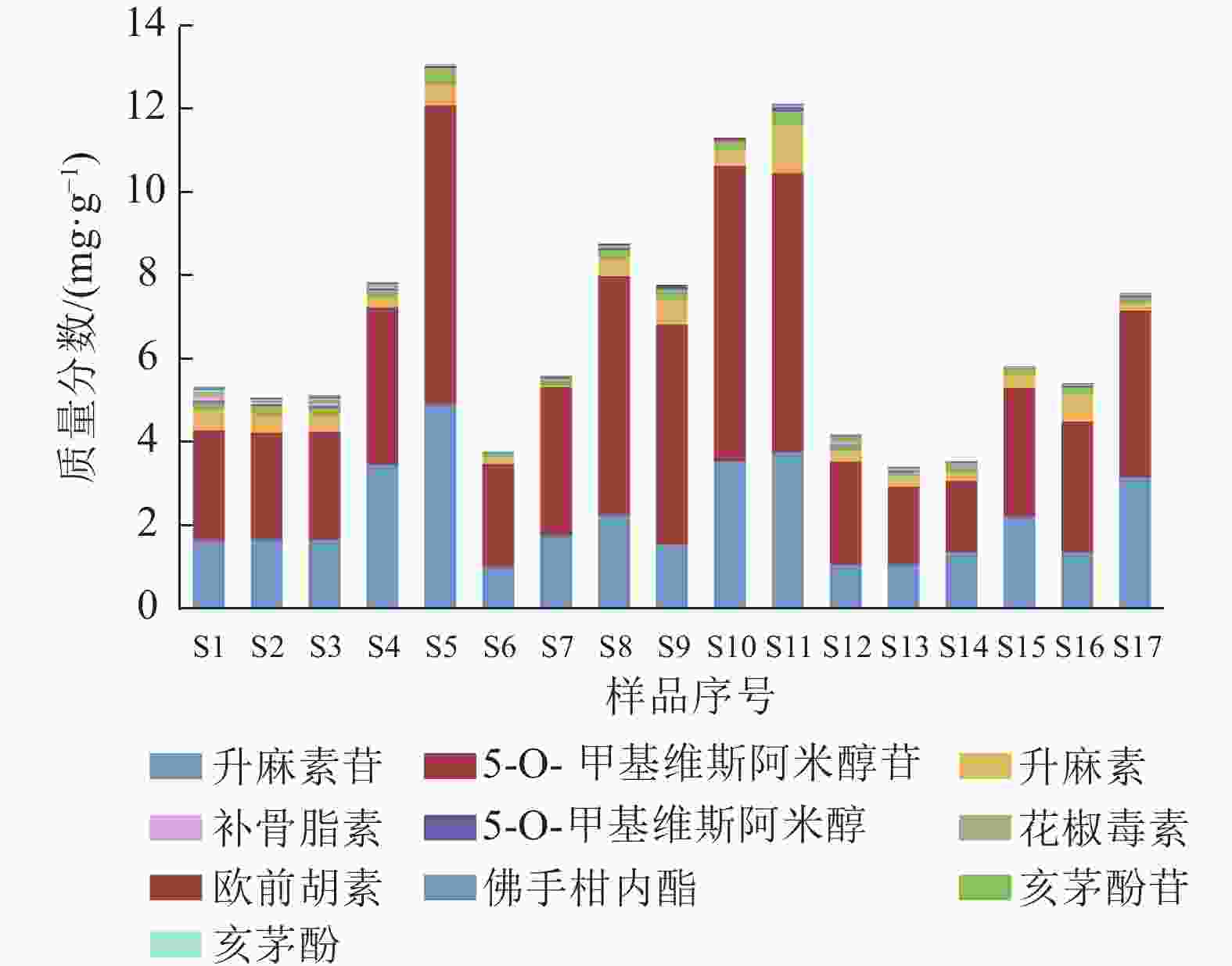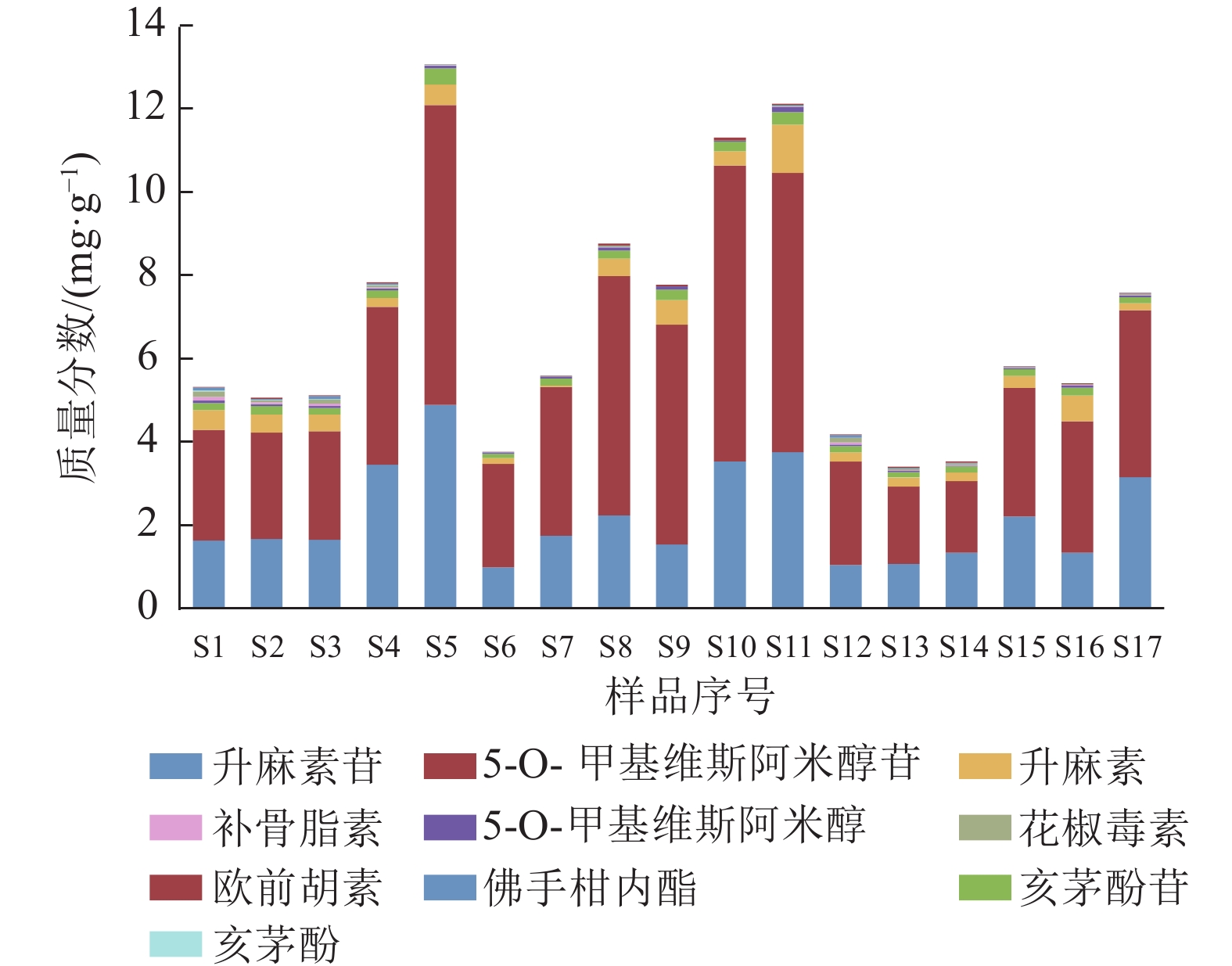-
防风Saposhnikovia divaricata为伞形科Apiaceae多年生草本植物,以未抽薹的干燥根入药。其味辛、甘,性温,归膀胱、肝、脾经,具有祛风解表、胜湿止痛、止痉之效,常用于治疗发烧、头痛、过敏性鼻炎、风湿性关节炎、免疫系统疾病等[1−4]。目前已从防风中分离出 100 多种化合物,其中色原酮、香豆素类化合物是其发挥药效的主要物质基础[5]。防风主要分布于内蒙古、辽宁、吉林、黑龙江、河北、河南、山东、甘肃等地区[6]。受生长环境、采收时间、种质资源等[7−8]因素的影响,不同产地的防风药效成分及其临床药效差异较大。
中药具有多成分、多靶点作用的特点,检测单一成分难以全面反映药材内在质量,因此多指标、多成分的质量控制已成为发展趋势。《中国药典》2020年版一部“防风”药材项下,将升麻素苷和5-O-甲基维斯阿米醇苷作为评价防风药材质量的中药指标成分,规定两者占比不得低于0.24%。但升麻素、亥茅酚苷、补骨脂素、花椒毒素、佛手柑内酯、欧前胡素等色原酮和香豆素化合物均为表征不同产地、不同年限、不同商品规格的防风药材质量的特征成分,也都具有一定的抗菌、解热抗炎的功效[9−13]。因此,仅以升麻素苷和5-O-甲基维斯阿米醇苷作为防风药材的质量标志物(Q-Marker),无法全面评价防风的内在质量,为此,亟需建立完整的防风质量评价体系。
近年来,与炎症相关的疾病发病率逐年递增,寻找一种安全有效的抗炎药物成为研究的热点[14−15]。临床及实验证实很多中药具有很好的抗炎作用,且毒副作用小[16−17]。防风药材质量的差异可能会导致活性成分的差异进而呈现不同的临床疗效。目前关于不同产地防风药材抗炎活性的研究较少,且抗炎活性成分尚未明确,不利于其进一步开发利用。本研究通过建立防风药材多指标成分的高效液相色谱(HPLC)测定方法,结合建立脂多糖诱导的RAW 264.7小鼠巨噬细胞炎症模型,通过化学成分和药效指标相关联,筛选出与抗炎作用相关的药效成分群,探讨防风抗炎作用的药效基础,为完善防风药材质量标准提供依据。
-
2022年9—10月,分别在内蒙古自治区、吉林省、河北省、新疆维吾尔自治区等采集17批防风样品(表1),经吉林农业大学中药材学院韩忠明教授鉴定为伞形科植物防风的干燥根。将防风根洗净泥沙,置于恒温干燥箱中60 ℃烘干至恒质量,粉碎后过60目筛,备用。
样品序号 产地 生长年限 /a 样品序号 产地 生长年限 /a S1 内蒙古自治区赤峰市松山区南地村 1 S10 吉林省白城市永茂林场 2 S2 内蒙古自治区赤峰市松山区柳条沟村 1 S11 吉林省白城市枫林湾中药材种植基地 2 S3 内蒙古自治区赤峰市松山区西道村 1 S12 河北省承德市隆化县兴隆庄村 1 S4 内蒙古自治区通辽市科尔沁区庆和林场 1 S13 河北省承德市丰宁满族自治县胡麻营村 1 S5 内蒙古自治区赤峰市林西县 2 S14 河北省承德市围场县天桥村 1 S6 吉林省长春市吉林农业大学药园 1 S15 新疆省维吾尔自治区阿勒泰哈巴河实验站 1 S7 吉林省白山市江源区平川村 1 S16 新疆省维吾尔自治区阿勒泰哈巴河实验站 1 S8 吉林省白山市江源区平川村 2 S17 新疆省维吾尔自治区阿勒泰哈巴河实验站 2 S9 吉林省白城市青山林场 2 Table 1. Sample information of 17 batches of Saposhnikoviae radix
升麻素苷、5-O-甲基维斯阿米醇苷、升麻素、亥茅酚苷、补骨脂素、花椒毒素、佛手柑内酯、欧前胡素对照品(批号分别为111522-202214、111523-202212、111710-200602、111714-200501、110739-202319、112077-202101、112078-202101、110826-202219),均购自中国食品药品检定研究院;5-O-甲基维斯阿米醇、亥茅酚对照品(批号分别为B23192、B23109),均购自源叶生物科技有限公司。
-
称取防风粉末0.2 g于锥形瓶中,加6 mL甲醇溶液,超声提取1 h,放冷,用甲醇补足质量,摇匀,过0.22 μm滤膜,即得供试品溶液。配置1 mL甲醇溶液含升麻素苷0.110 μg、5-O-甲基维斯阿米醇苷0.170 μg、升麻素0.018 μg、亥茅酚苷0.014 μg、5-O-甲基维斯阿米醇0.002 μg、补骨脂素0.002 μg、花椒毒素0.003 μg、亥茅酚0.002 μg、佛手柑内酯0.001 μg、欧前胡素0.004 μg的混合溶液为对照。
取5 g防风粉末,按液料比为1∶30 (质量体积比)加入甲醇溶液,超声提取1 h,旋蒸浓缩至10 mL,冷冻干燥,得不同批次的提取物冻干粉。取冻干粉 10 mg,溶于4 mL RAW 264.7培养基中,制成质量浓度为 2.5 g·L−1的母液,于4 ℃避光保存。
-
色谱条件:色谱柱 Supfex AQ-C18(4.6 mm×250.0 mm,5 μm),流动相为水(A)-乙腈(B)梯度洗脱(0~8 min,20.0%~40.5%B;8~20 min,40.5%~55.0%B;20.0~25.0 min,55%B,25.0~35.0 min,55.0%~65.0%B,35.0~40.0 min,65.0%~80.0%B),流速1 mL·min−1,柱温25 ℃,波长254 nm,进样量 15 μL。
-
吸取混合对照品溶液1、5、10、15、20 μL,注入液相色谱仪进行测定,以进量(x,μg)为横坐标,峰面积(y)为纵坐标进行线性回归,计算线性回归方程和相关系数。
-
分别取混合对照品溶液、样品溶液、空白溶剂(体积分数为100%的甲醇),根据“1.3” 色谱条件分别进样15 μL,比较色谱图。
-
精密吸取同一混合对照品溶液15 μL,根据“1.3”色谱条件测定升麻素苷等10种物质的峰面积(RSD)。重复6次。
-
精密吸取同一供试品溶液15 μL,分别于0、2、4、8、12、24 h进样,按照“1.3”色谱条件测定10种物质的RSD值。重复6次。
-
分别精密称取同一批供试品6份,根据“1.2”方法制备供试品溶液,按照“1.3”色谱条件测定10种物质的RSD值。重复6次。
-
取对数生长期细胞,2.5×104个·孔−1细胞接种于96孔板,设置仅含完全培养基的空白对照组和用完全培养基稀释成质量浓度为100、200、400、600、800 mg·L−1 的防风醇提物组,药物干预24 h后,采用CCK-8法检测不同质量浓度防风醇提物对RAW 264.7细胞活性的影响,细胞存活率=(加药组吸光度−空白组吸光度)/(正常组吸光度−空白组吸光度)×100%。结果显示:当防风醇提物质量浓度低于200 mg·L−1时对RAW 264.7细胞活性无影响。将细胞以2.5×104个·孔−1接种于96孔板中,培养24 h后,弃上清液,根据CCK-8细胞活力检测结果,设置正常对照组、模型对照组(LPS质量浓度为5 mg·L−1)和防风醇提物组(防风醇提物200 mg·L−1与 LPS 5 mg·L−1)共同干预细胞。药物干预细胞24 h后,取细胞上清按试剂盒说明书检测一氧化氮(NO)、白细胞介素6 (IL-6)和白细胞介素1β (IL-1β)含量。
-
根据17批防风样品中10种化学成分的质量分数,用Metaboanalyst 5.0进行系统聚类;将10种化学成分的质量分数标准化处理后进行主成分分析,得相关系数的特征值和方差贡献率;将10种化学成分与NO、IL-6和IL-1β的表达量进行相关性分析;采用均值化法对数据进行无量纲化处理,以NO、IL-6和IL-1β水平为参考序列,以化学成分质量分数为比较序列,求参考序列与比较序列的灰色关联系数[18]。采用SPSS 21.0进行显著性检验(α=0.05)、主成分分析以及相关性分析,采用Excel 22.0进行灰色关联度分析,采用Metaboanalyst 5.0进行聚类分析绘图,Origin 2022软件进行柱形图绘制。
-
表2显示:升麻素苷、5-O-甲基维斯阿米醇苷、升麻素、亥茅酚苷、5-O-甲基维斯阿米醇、补骨脂素、花椒毒素、亥茅酚、佛手柑内酯、欧前胡素等10种化学成分的线性关系良好,决定系数(R2)均大于0.999 0。专属性试验结果(图1)可见:空白溶剂对样品的检测无干扰。精密度试验测得升麻素苷等10种化学成分的RSD分别为0.61%、0.54%、0.53%、0.62%、0.50%、0.69%、0.69%、2.10%、0.63%和1.16%,表明该方法精密度良好。稳定性试验测得10种化学成分的RSD分别为1.15%、0.80%、0.75%、0.98%、1.32%、0.77%、0.84%、4.16%、1.68%和1.29%,表明该方法稳定性良好。重复性试验测得10种化学成分的RSD分别为4.58%、1.62%、1.62%、1.71%、1.24%、3.10%、1.69%、4.76%、1.50%和1.88%,表明该方法重复性良好。
成分 回归方程 R2 线性范围/μg 升麻素苷 y=2250.7x+24.200 0.999 6 0.110~1.130 5-O-甲基维
斯阿米醇苷y=1947.2x+79.014 0.999 1 0.170~3.000 升麻素 y=2401.8x+5.534 0.999 6 0.018~0.350 亥茅酚苷 y=2693.3x+0.829 0.999 9 0.014~0.280 5-O-甲基维
斯阿米醇y=2915.1x−0.029 0.999 9 0.002~0.040 补骨脂素 y=3480.5x+0.555 0.999 9 0.002~0.040 花椒毒素 y=4947.8x+0.905 0.999 9 0.003~0.060 亥茅酚 y=3119.3x−2.227 0.999 2 0.002~0.040 佛手柑内酯 y=4601.6x+0.230 0.999 9 0.001~0.020 欧前胡素 y=4115.7x+0.172 0.999 8 0.004~0.080 说明: x指进量(mg); y指峰面积。 Table 2. Results of linear relationship between ten components of Saposhnikoviae radix
-
由图2可见:17批防风样品升麻素和5-O-甲基维斯阿米醇苷质量分数总和为 2.93~12.09 mg·g−1 ,均符合《中国药典》(2020年版)防风项下规定升麻素苷、5-O-甲基维斯阿米醇苷2种成分质量分数总和不少于0.24%的规定。其中产自内蒙古自治区赤峰市林西的S5 10种化学成分质量分数最高,为13.06 mg·g−1;河北省承德县胡麻营的S13 10种化学成分质量分数最低,为3.41 mg·g−1,两者相差3.83倍。防风中10种化学成分质量分数差异较大,质量分数从高到低分别为5-O-甲基维斯阿米醇苷、升麻素苷、升麻素、亥茅酚苷、5-O-甲基维斯阿米醇、花椒毒素、欧前胡素、佛手柑内酯、补骨脂素、亥茅酚。
-
由图3可见:17批防风样本聚为4类,产自内蒙古的S5和吉林的S8~S11聚为第一大类,表现为富含升麻素苷、5-O-甲基维斯阿米醇苷、升麻素、亥茅酚苷、5-O-甲基维斯阿米醇和欧前胡素;产自内蒙古的S1~S4聚为第二大类,表现为富含补骨脂素、花椒毒素、亥茅酚、佛手柑内酯;产自河北的S12~S14聚为第三大类,补骨脂素、花椒毒素、佛手柑内酯质量分数相对较高;产自吉林的S6~S7和新疆的S15~S17聚为第四大类,10种化学成分质量分数相对较低。整体来看,防风药材样本具有一定的区域特征,但同一产地不同批次的药材之间存在差异性,这可能是因为生长年限、土壤、降水量等因子影响了防风次生代谢产物的积累。
-
由表3可见:以主特征值>1为提取标准,提取3个主成分,分别代表了变量总方差的44.033%、28.648%、10.611%,累计贡献率达83.292%,大于80.00%。这表明这3个主成分是影响防风质量评价的主要因子,可全面反映防风药材的综合质量特征。以提取的主成分的因子得分乘以相应主成分特征值的算术平方根计算综合得分,对17批防风样品进行综合评价,结果见表4。来自内蒙古的S5和吉林的S8~S11综合得分在1以上,质量相对较好;来自内蒙古的S1和河北的S12综合得分较低,质量相对较差。
主成分 特征值 方差/% 累积贡献率/% 1 4.403 44.033 44.033 2 2.865 28.648 72.681 3 1.061 10.611 83.292 Table 3. Eigenvalue and cumulative variance contribution rates
样品 综合得分 样品 综合得分 S1 −2.05 S10 2.41 S2 −0.51 S11 4.39 S3 −1.91 S12 −2.52 S4 0.16 S13 −1.92 S5 3.77 S14 −1.72 S6 −1.91 S15 −0.71 S7 −0.74 S16 −0.03 S8 1.56 S17 −0.16 S9 1.88 Table 4. Comprehensive score value of 17 batches of Saposhnikoviae radix
-
由表5可见:与正常对照组比较,模型对照组NO、IL-6和IL-1β质量浓度显著升高(P<0.01),说明RAW 264.7炎性模型造模成功;与模型对照组比较,各受试药物组可不同程度地降低NO、IL-6和IL-1β水平,说明防风醇提物质量浓度为200 mg·L−1时具有一定的抗炎效果。其中防风样品S8~S11、S17对细胞中炎症因子NO表达量具有较强的抑制作用,S7、S9~S11、S17对细胞中炎症因子IL-6表达量具有较强的抑制作用,S5、S8~S11对炎症因子IL-1β表达量具有较强的抑制作用。可能因为防风样品S5、S8~S11中富含升麻素苷、5-O-甲基维斯阿米醇苷、升麻素、亥茅酚苷、5-O-甲基维斯阿米醇和欧前胡素,且综合质量较高,样品S7、S17中具有其他低成分高活性的物质,因此抗炎活性较强。
组别 NO/(μmol·L−1) IL-6 /(μg·L−1) IL-1β/(ng·L−1) 组别 NO/(μmol·L−1) IL-6 /(μg·L−1) IL-1β/(ng·L−1) 正常对照 2.57±0.32 2.00±0.55 63.53±2.60 S9 20.02±0.94** 28.50±1.68** 138.09±17.62** 模型对照 37.57±3.39## 57.88±1.35## 227.92±26.06## S10 19.02±0.71** 24.45±2.29** 125.46±6.26** S1 29.60±1.30** 40.97±2.22 207.76±5.80* S11 10.02±2.36** 24.21±2.36** 127.43±7.70** S2 20.77±0.82** 42.07±1.89** 181.86±2.09** S12 24.85±3.54** 45.73±1.28** 140.71±14.37** S3 35.10±0.35 45.40±2.56** 178.25±1.62** S13 35.35±0.47 35.54±1.41** 180.71±10.66** S4 23.43±0.12** 38.02±1.82** 138.25±20.17** S14 26.77±1.77** 45.83±7.21** 167.92±8.35** S5 26.35±2.36** 36.59±3.03** 112.35±3.48** S15 25.60±0.82** 57.50±1.75 159.07±28.28** S6 36.93±0.82 40.26±0.27** 214.32±5.80 S16 25.52±2.83** 36.11±0.34** 176.94±6.72** S7 24.35±4.71** 29.59±1.21** 173.33±9.51** S17 20.43±2.71** 34.88±3.17** 147.60±5.10** S8 18.02±1.41** 35.59±0.54** 135.46±7.42** 说明:防风醇提物剂量均为200 mg·L−1。与正常对照组比较,*P<0.05,**P<0.01;与模型组比较,##P<0.01。 Table 5. Anti-inflammatory capacity of 17 batches of Saposhnikoviae radix
-
将10个化学成分与NO、IL-6和IL-1β的表达量进行相关性分析(表6)表明:升麻素苷、5-O-甲基维斯阿米醇苷、升麻素、亥茅酚苷和5-O-甲基维斯阿米醇与NO表达量呈显著或极显著负相关,5-O-甲基维斯阿米醇苷、5-O-甲基维斯阿米醇、欧前胡素与IL-6表达量呈显著或极显著负相关,升麻素苷、5-O-甲基维斯阿米醇苷、亥茅酚苷与IL-1β表达量呈显著或极显著负相关,表明升麻素苷、5-O-甲基维斯阿米醇苷、升麻素、亥茅酚苷、5-O-甲基维斯阿米醇、欧前胡素与抗炎活性呈正相关,是防风发挥抗炎作用的主要活性成分。
成分 药效指标 NO 1L-6 IL-1β 升麻素苷 −0.512* −0.392 −0.736** 5-O-甲基维斯阿米醇苷 −0.658** −0.703** −0.787** 升麻素 −0.543* −0.442 −0.315 亥茅酚苷 −0.534* −0.456 −0.690** 5-O-甲基维斯阿米醇 −0.599* −0.540* −0.391 补骨脂素 0.268 0.319 0.424 花椒毒素 0.322 0.424 0.329 亥茅酚 0.212 0.219 0.346 佛手柑内酯 0.349 0.380 0.307 欧前胡素 −0.474 −0.535* −0.386 说明:*表示显著相关(P<0.05);**表示极显著相关(P<0.01)。 Table 6. Canonical correlation analysis of components and pharmacodynamics indexes
-
由表7可见:与NO表达量有较大关联性的成分贡献从大到小依次为亥茅酚苷、5-O-甲基维斯阿米醇、5-O-甲基维斯阿米醇苷、升麻素苷、升麻素、花椒毒素、佛手柑内酯、欧前胡素、补骨脂素、亥茅酚;与IL-6表达量有较大关联性的成分贡献从大到小依次为亥茅酚苷、5-O-甲基维斯阿米醇、5-O-甲基维斯阿米醇苷、升麻素苷、升麻素、花椒毒素、欧前胡素、佛手柑内酯、补骨脂素、亥茅酚;与IL-1β表达量有较大关联性的成分贡献从大到小依次为亥茅酚苷、5-O-甲基维斯阿米醇、升麻素、5-O-甲基维斯阿米醇苷、升麻素苷、花椒毒素、欧前胡素、佛手柑内酯、补骨脂素、亥茅酚。各化学成分与各药效指标的关联度均大于0.6,说明防风体外抗炎作用是多组分协同作用的结果。其中升麻素苷、5-O-甲基维斯阿米醇苷、升麻素、亥茅酚苷、5-O-甲基维斯阿米醇与NO、IL-6、IL-1β表达量的关联系数排名靠前且均大于0.8,说明这5种化学成分对防风发挥抗炎活性的贡献较大。
成分 NO IL-6 IL-1β 灰色关联度 排名 灰色关联度 排名 灰色关联度 排名 升麻素苷 0.801 4 0.813 4 0.801 5 5-O-甲基维斯阿米醇苷 0.806 3 0.818 3 0.806 4 升麻素 0.800 5 0.809 5 0.819 3 亥茅酚苷 0.849 1 0.862 1 0.859 1 5-O-甲基维斯阿米醇 0.842 2 0.853 2 0.840 2 补骨脂素 0.737 9 0.762 9 0.732 9 花椒毒素 0.781 6 0.793 6 0.778 6 亥茅酚 0.700 10 0.703 10 0.675 10 佛手柑内酯 0.758 7 0.769 8 0.757 8 欧前胡素 0.753 8 0.775 7 0.769 7 Table 7. Grey correlation between chemical composition contents and anti-inflammatory index
-
目前,关于防风的药材质量标准研究大多为单一种类成分的测定,且研究成分数量较少[19−21]。本研究采用HPLC-DAD法同时测定防风中6种色原酮和4种香豆素成分的质量分数。在供试品溶液制备过程中,本研究考察了超声和加热回流2种常用的提取方式,以及不同提取溶剂、料液比、超声时间对防风中10种化学成分提取率的影响,结果显示:提取溶剂体积分数为100%甲醇、液料比为1∶30(质量体积比)、超声提取60 min时防风中化学成分提取率最高。在《中国药典》(2020版)和文献[22−23]的洗脱方法基础上进行优化,发现当柱温为25 ℃,流速为1 mL·min−1时基线平稳,峰形良好,各成分分离度高。该方法专属性强,准确度和分离度良好,能较全面有效地评价防风质量,为其质量控制提供参考依据。
高质量道地药材不仅主要成分含量较高,而且高活性成分含量也较高[24]。由于不同产地生态环境因素的差异,导致药用植物生理生化反应及体内代谢不同。体内次生代谢产物的形成和积累发生变化,使得药材质量发生变化[25],但植物次生代谢产物的形成和积累不仅与生长环境有关,也与其生长年限有关[26]。本研究聚类分析结果也显示:17批防风药材呈现一定的区域性特征,并且同一产地不同生长年限的药材之间也存在差异性,内蒙古、吉林产地2年生防风药材中升麻素苷、5-O-甲基维斯阿米醇苷、升麻素、亥茅酚苷、5-O-甲基维斯阿米醇质量分数和10种化学成分总质量分数明显高于其1年生防风药材,说明防风药材质量不仅具有一定地域性,同时其药材有效成分含量的高低也受到种植年限的影响。17批防风药材中以吉林、内蒙古产区的2年生防风药材综合得分较高,综合质量较优,与河北产地的药材质量存在较大的差异。该结果与防风的道地药材主要分布于内蒙古扎鲁特旗以北和吉林西部的结论相符合[27]。
本研究通过体外细胞试验表明:不同产地的防风醇提物均能不同程度地降低NO、IL-6和IL-1β的表达量。通过双变量相关性分析和灰色关联度分析发现:升麻素苷、5-O-甲基维斯阿米醇苷、升麻素、亥茅酚苷、5-O-甲基维斯阿米醇能显著降低 LPS 诱导的RAW 264.7炎症细胞上清液中NO、IL-6、IL-1β的表达,且与这3个细胞炎症指标的关联系数较大。有研究表明:升麻素苷、5-O-甲基维斯阿米醇苷、升麻素、亥茅酚苷、5-O-甲基维斯阿米醇通过抑制 NF-κB 和MAPKs信号通路减轻LPS诱导的RAW 264.7细胞炎症反应[28−30]。推测以上5个成分可能是防风抗炎活性的关键物质基础。
-
本研究建立了防风药材多指标质量分数的测定方法,并筛选出升麻素苷、5-O-甲基维斯阿米醇苷、升麻素、亥茅酚苷、5-O-甲基维斯阿米醇为防风药理作用的关键活性成分。不同产地和不同生长年限防风药材的化学成分质量分数、抗炎活性之间存在差异,17批药材中以内蒙古和吉林的2年生防风药材综合质量较优,因此入药时,要充分考虑防风的产地和生长年限,才能保证临床疗效的稳定性。
Comprehensive quality evaluation of Saposhnikoviae radix based on multi-component contents determination
doi: 10.11833/j.issn.2095-0756.20230567
- Received Date: 2023-11-24
- Accepted Date: 2024-04-23
- Rev Recd Date: 2024-04-22
- Available Online: 2024-07-12
- Publish Date: 2024-07-12
-
Key words:
- Saposhnikovia divaricata /
- chromone /
- coumarin /
- anti-inflammatory /
- correlation analysis
Abstract:
| Citation: | MA Bingru, CUI Jingxuan, WANG Yuyi, et al. Comprehensive quality evaluation of Saposhnikoviae radix based on multi-component contents determination[J]. Journal of Zhejiang A&F University, 2024, 41(4): 715-723. DOI: 10.11833/j.issn.2095-0756.20230567 |













 DownLoad:
DownLoad:

